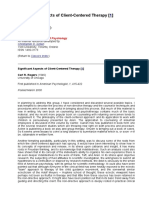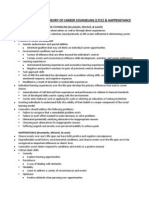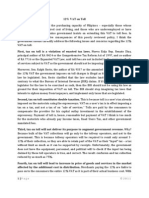Positive Psychology
Positive Psychology
Uploaded by
Chariss GarciaCopyright:
Available Formats
Positive Psychology
Positive Psychology
Uploaded by
Chariss GarciaCopyright
Available Formats
Share this document
Did you find this document useful?
Is this content inappropriate?
Copyright:
Available Formats
Positive Psychology
Positive Psychology
Uploaded by
Chariss GarciaCopyright:
Available Formats
EMERGENCE OF POSITIVE PSYCHOLOGY y y y y Before World War II, psychology had three distinct missions: curing mental illness,
making the lives of all people more productive and fulfilling, and identifying and nurturing high talent Shortly after WWII, the primary focus of psychology shifted to the first priority: treating abnormal behavior and mental illness. During the 1950s, humanist thinkers such as Carl Rogers, Erich Fromm and Abraham Maslow helped renew interest in the other two areas by developing theories that focused on happiness and the positive aspects of human nature. Positive psychology began as a new area of psychology in 1998 when Martin Seligman, considered the father of the modern positive psychology movement, chose it as the theme for his term as president of the American Psychological Association, though the term originates with Maslow, in his 1954 book Motivation and Personality - In his inaugural speech, Seligman, who had worked on depression for 30 years, stunned his audience by saying psychologists had missed a trick. Rather than devoting attention to lives that had gone desperately wrong, psychologists should change tack, focusing instead on people for whom everything was going well. While psychologists knew virtually all there was to know about depression, he said, they knew almost nothing of the secrets of a happy life. Discover what they are and it might give you a recipe that people could learn to make themselves happier and more satisfied with their lives. The first positive psychology summit took place in 1999 The First International Conference on Positive Psychology took place in 2002 In 2006, Harvard's course on positive psychology became the university's most popular class
y y y
POSITIVE PSYCHOLOGY is the scientific study of what makes life most worth living It is a call for psychological science and practice to be as concerned with strength as with weakness; as interested in building the best things in life as in repairing the worst; and as concerned with making the lives of normal people fulfilling as with healing pathology Focuses on human prospering how to make people happier By reminding ourselves what went well instead of what went wrong, positive psychologists believe we can build a buffer against unhappiness, making us better able to take life's knocks when they come. Intends to complement, not replace traditional psychology - Positive psychologists seek "to find and nurture genius and talent", and "to make normal life more fulfilling", not simply to treat mental illness. It does not seek to deny the importance of studying how things go wrong, but rather to emphasize the importance of using the scientific method to determine how things go right. Positive psychology does not involve ignoring the very real problems that people face and that other areas of psychology strive to treat Positive psychologists analyze things like states of pleasure or flow, values, virtues, talents, as well the ways that they can be promoted by social systems and institutions - Martin Seligman and Mihaly Csikszentmihalyi describe positive psychology in the following way: "We believe that a psychology of positive human functioning will arise that achieves a scientific understanding and effective interventions to build thriving in individuals, families, and communities." -
RESEARCH FINDINGS IN POSITIVE PSYCHOLOGY y y People are generally happy Money doesn't necessarily buy well-being; but spending money on other people can make individuals happier. Seligman believes that once we have enough to pay for life's basics such as food and a roof over our heads, more money adds little to our happiness. Some of the best ways to combat disappointments and setbacks include strong social relationships and character strengths
y y y y y y y y
Happiness is a cause of good things in life and not simply along for the happy ride. People who are satisfied with life eventually have even more reason to be satisfied, because happiness leads to desirable outcomes at school and work, to fulfilling social relationships, and even to good health and long life. Most people are resilient. Happiness, strengths of character, and good social relationships are buffers against the damaging effects of disappointments and setbacks. Crisis reveals character. Other people matter mightily if we want to understand what makes like most worth living. Religion matters. The "heart" matters more than the "head." Schools explicitly teach critical thinking; they should also teach unconditional caring. Good days have common features: feeling autonomous, competent, and connected to others. The good life can be taught. While happiness is influenced by genetics, people can learn to be happier by developing optimism, gratitude and altruism
STRENGTHS OF POSITIVE PSYCHOLOGY a. Front and center awareness of limitations of the medical model - Historically, mental health fields have functioned in a passive-receptive mode, i.e., waiting for troubles to become manifest and, at that point, doing the best that can be done to contain or repair malfunction. However understandable the emergence of that model often called the medical model and whatever its successes, it has become increasingly clear that it is: (a) insufficient as a comprehensive societal model; and (b) often doomed to failure before it can even come into play; Among the model s major shortcomings are serious limitations in its: (a) reach and applicability to diverse groups in need; and (b) effectiveness with longstanding dysfunction. b. Guiding focus on positive outcomes c. Implicit belief that the achievement of positive outcomes may, in the long run, be the most sensible and pragmatic way of addressing (averting) major problems of psychological disorder. Thus, Seligman and Czikszentmihalyi (2000) state: the major strides in prevention have come largely from a perspective focused on systematically building competence, not on correcting weakness, and further that, psychology is not just the study of pathology, weakness, and damage; it is also the study of strength and virtue. Treatment is not just fixing what is broken; it is nurturing what is best . WEAKNESSES OF POSITIVE PSYCHOLOGY 1. The definitions of positive psychology are misunderstood by so many people. Most people think that if there is a positive psychology the rest of it is about negative psychology. 2. Positive psychology needs to consider effects of cultural differences because what is good and bad is not that simple. It is complex and multidimensional. If we want to say one is good or bad we should think more universally and have studies in different cultures about positive psychology. 3. Some strengths are not very clearly described. For example: optimism is seen as good, but it can have bad outcomes too. Defense optimism can be one example for it. Scholars should be more detailed and careful when they describe the definitions and outcomes of those strengths. LIMITS OF POSITIVE PSYCHOLOGY 1. Defensive pessimist - For defensive pessimists, worrying about upcoming challenges is a way of life. But it's also a healthy coping strategy that helps them prepare for adversity. Wellesley psychologist Julie Norem has shown that when defensive pessimists are deprived of their pessimism by being forced to look on the bright side of life, their performance on tasks plummets. 2. People with high self-esteem - For participants with high self-esteem, repeating a positive self-statement ("I'm a lovable person") made them feel a bit better, but not all that much. But of course, people with high-esteem rarely need to repeat positive self-statements, as they already like themselves.
3. People with low self-esteem - Joanne Wood of the University of Waterloo and two colleagues found that repeating a positive self-statement actually made them feel worse, probably because doing so underscored the discrepancy between how they feel about themselves and how they want to feel about themselves. In all likelihood, it just reminded them of how unlovable they really feel. 4. Anger - In a study by Maya Tamir angry people were actually more successful at confrontational games than non-angry people. To put this in a real life scenario imagine all those irate airline passengers you see confronting agents at the airport about delayed or missed flight connections. You and I would like to believe that a friendly smile and a wink would be more effective, but it may be that anger is associated with stronger self-advocacy and less compromise. As further evidence Tamir and her colleagues conducted follow-up research in which they found that angry people were more likely to get refunds and have others acquiesce to their demands. Rage may not be good for long term relationships, and it certainly isn't pleasant, but it can be effective-even more effective than happiness in some situations. 5. Fear - This is particularly true when people are pursuing "avoidant" rather than "approach" goals. Simply put, there are two basic kinds of goals. Approach goals are those that seek out a positive outcome as in the example of "I would like to buy some chocolate cake so that I can have a delicious dessert!" Avoidance goals are those that seek to avoid a negative outcome as in the example of "I am going to pass on the chocolate cake because I want to avoid getting fat." In a series of studies Maya Tamir and her colleagues found clear evidence that people prefer fear when pursuing avoidant goals. Despite the unpleasantness of fear people appear to recognize that it will help them better achieve certain types of goals. NOTE: The pressure to be happy makes people less happy. Organizing your life around trying to become happier, making happiness the primary objective of life gets in the way of actually becoming happy. CHAPTER 3: Positive Psychological Assessment in an Increasingly Diverse World by Lisa Y. Flores and Ezemenari M. Obasi Psychology has been criticized because theories have been based on White, middle-class values and research is conducted on mainstream samples Cross-cultural psychology aims to redress these criticisms by focusing on the experiences of a broad range of people
Sue & Sue (1999) have categorized historical and contemporary psychological research paradigms with racial-ethnic groups into the following 3 areas: 1) Genetically deficient model highlighted biological differences to explain intellectual aptitudes between different racial groups - Aim: to scientifically illustrate the intellectual superiority of the European race and to hierarchically categorize intellectual capacity as a function of race - Examples: (1) Darwin s Origin of Species by Means of Natural Selection, (2) hypothesis that Africans had inferior brains and limited intellectual capacity was illustrated by measuring the differential amount of pepper corns held in the skulls of African and Europeans 2) Culturally deficient model the communal lifestyles and values of various racial-ethnic groups were identified as the factors that perpetuated the mental and intellectual inferiority of certain racial and ethnic populations - Looked at their environmental, nutritional, psychological, socio-cultural and linguistic factors to explain how members from different groups were prevented from developing optimally - Set the dominant European American middle-class cultural values and lifestyles as the ideal measuring stick and regarded anything that deviated from this norm as deficient 3) Culturally different model view alternative values and lifestyles as legitimate - Rather than comparing cultures to one another and placing one culture in a superior position in relation to other cultures, differences are appreciated, practices and behaviors are understood and interpreted within the context of the culture, and the benefits of living in a culturally diverse society are honored - Essentially, the strengths and values of multiple cultures are recognized and respected from a culturally different perspective
Assessment process of understanding and helping people (Walsh and Betz, 2001). Importance of recognizing the reciprocal relationship between the person and his/her environment Information regarding the cultural environment, explanations for behaviors, and characterizations of behaviors from the perspective of individuals who are part of the culture are essential components of cross-cultural assessment Culturally sensitive psychological assessment is a multi-faceted process and several issues must be taken into account in the construction of positive psychological measurements for use in research and practice
Methods of Assessment: a) Formal paper and pencil tests b) Informal talking to the person, talking to the person s family and friends Guidelines in Conducting an Assessment: 1. Researcher must understand the meaning of positive constructs among diverse cultural groups 2. Measures are constructed from the worldview perspective of the cultural group for which it is intended to be used 3. Interpretations from research studies are articulated in a manner that improves the community s current condition in a culturally sensitive way and is validating to their sense of humanity 4. Researcher should recognize that every cultural group is not homogenous Major Concerns: 1. Construct: Etic Versus Emic Issues - Conceptual equivalence whether the construct being measured has the same meaning for all individuals - Etic similar across cultures VS Emic culturally specific - Example: In Ghanian culture, it is taboo for a child to ask an elder how she/he is doing it is understood that a certain level of wisdom is inherent in one s transition into eldership, and that a child will have little assistance to offer if the elder s reply to the question is not good. However, this is a common inquiry among young people in the US 2. Standardization use of measures that lack adequate representation of individuals representing diverse racial-ethnic groups or individuals from different countries in the normative samples usually derived from samples made up of predominately European American, middle-class and college educated individuals 3. Language - Linguistic equivalence occurs when measures are translated into a different language without adequate consideration of whether concepts can be translated accurately into that particular foreign language - Using a bilingual expert to translate the measure into the foreign language, and then having another person skilled in both languages translate it back into the original language can minimize bias 4. Scaling scaling issues can be minimized when researchers understand the decision-making process of the individual - Example: European Americans prefer Likert scale 5. Response Bias emotions are consistently reported at either extreme or at midlevels - Example: In cultures that value collectivism and place higher value on group conformity, behaviors that draw attention to individuals may be frowned on (Sue and Sue, 1999) - Researchers must develop a rapport with their research participants to get a full understanding of the barriers that may prevent them from answering questions truthfully or in a socially desirable manner 6. Examiner bias researcher must understand the intricacies of the culture and can approximately interpret the responses and behaviors of the individual - They should have a basic background on the particular culture of interest thru reading relevant literature and engaging in culture-specific activities that provide an invaluable atmosphere to learn about particulars that are meaningful to that culture - They must be aware of their personal biases when attempting to make constructive interpretations
7. Cultural variables such as acculturation level, racial identity, socioeconomic status, and worldview could influence the assessment process may serve as moderating variables - Cultural components are critical in both assessment and research because culture can affect one s definition, evaluation and explanation of behaviors Areas to Improve in the Study of Positive Psychology: 1. Generate research that tests the applicability of positive psychological measures with racial-ethnic groups in the US along with international samples, thus providing normative data to support the use of these measures 2. Investigate the relationship of positive psychology constructs to other psychological variables in different cultural groups 3. Collaborate with cross-cultural psychologists from other areas of psychology who have expertise with particular groups and knowledge regarding cross-cultural research and assessment 4. Encourage an increase in the number of scholars and graduate students in the field of positive psychology who express interests in studying positive psychological functioning in culturally diverse populations 5. Apply the findings from positive psychology s research to improve the functioning and status of culturally diverse groups by building on the strengths and values within the culture REFERENCES: Lopez, S. & Snyder, C.R. (eds.). (2003). Positive Psychological Asssessment: A Handbook of Models and Measures. Washington D.C., USA: American Psychological Association. http://psychology.about.com/ http://en.wikipedia.org/wiki/Positive_psychology http://www.psychologytoday.com/
You might also like
- Yamaha FZ CatalogueDocument55 pagesYamaha FZ CatalogueAnonymous KoA00wXXD81% (79)
- Places That Matter: Knowing Your Neighborhood through DataFrom EverandPlaces That Matter: Knowing Your Neighborhood through DataNo ratings yet
- Value Chain Analysis: Australian Wine IndustryDocument18 pagesValue Chain Analysis: Australian Wine IndustryChariss Garcia100% (1)
- Career Guidance Intake InterviewDocument33 pagesCareer Guidance Intake InterviewAlexandra AlasNo ratings yet
- Case Analysis Volunteerism RectoDocument2 pagesCase Analysis Volunteerism RectoSue Recto100% (1)
- Career Counselling TheoriesDocument6 pagesCareer Counselling TheoriesAhmed JavedNo ratings yet
- CH 8 GestaltDocument10 pagesCH 8 GestaltKadir Say'sNo ratings yet
- Validating and Using The Career Beliefs Inventory: Johns Hopkins UniversityDocument12 pagesValidating and Using The Career Beliefs Inventory: Johns Hopkins Universityyinyang_trNo ratings yet
- Reality Theory and Its Use in Group CounselingDocument7 pagesReality Theory and Its Use in Group CounselingJdawg2100% (1)
- ASCA-National Model A Framework For School Counseling ProgramsDocument4 pagesASCA-National Model A Framework For School Counseling Programs4rlong100% (1)
- PSY2017 - CBT - Weeks 2-4Document105 pagesPSY2017 - CBT - Weeks 2-4Maria- MagdalenaNo ratings yet
- Constitutional and Philippine Political LawDocument45 pagesConstitutional and Philippine Political LawChariss Garcia100% (1)
- 1998 Magnum Chassis Owners ManualDocument50 pages1998 Magnum Chassis Owners ManualLeonard Nugent100% (2)
- Lisa Bennie Honours Thesis ReducedDocument67 pagesLisa Bennie Honours Thesis ReducedNur NadiahNo ratings yet
- Positive Psychology - The Balance Between Victomology and HappyologyDocument6 pagesPositive Psychology - The Balance Between Victomology and Happyologynima00No ratings yet
- Core Assumptions in Existential PsychotherapyDocument1 pageCore Assumptions in Existential Psychotherapyoana liminalaNo ratings yet
- Theories of Career Development - Week 2Document5 pagesTheories of Career Development - Week 2songofpsalmsNo ratings yet
- Case Conceptualization FormatDocument3 pagesCase Conceptualization FormatReymart Alvarez BoyoNo ratings yet
- Anne RoeDocument17 pagesAnne RoeBenjamin Josiah GranadaNo ratings yet
- Counseling Theories ApproachesDocument4 pagesCounseling Theories ApproachesCindy TanNo ratings yet
- Code of Ethics CounsellorsDocument5 pagesCode of Ethics CounsellorsJaynelyn BagaipoNo ratings yet
- Counseling ReportDocument15 pagesCounseling ReportMinagaFathmaSonnaya100% (1)
- Person-Centered Counseling Applied To Stan's CaseDocument2 pagesPerson-Centered Counseling Applied To Stan's CaseREMY JOY CABANNo ratings yet
- Lesson 2 The Skills Activities of A Clinical PsychologistDocument6 pagesLesson 2 The Skills Activities of A Clinical Psychologistjericho anchetaNo ratings yet
- Application Counseling ApproachesDocument6 pagesApplication Counseling ApproachesWinnie TunayNo ratings yet
- Human Values: Psychological Basis of BehaviourDocument13 pagesHuman Values: Psychological Basis of BehaviourITISHA JAIN100% (2)
- CounsellingDocument42 pagesCounsellingKannan KrishnamurthyNo ratings yet
- Carl Rogers 1Document10 pagesCarl Rogers 1Monica S. SantiagoNo ratings yet
- Counselling Approaches 1Document30 pagesCounselling Approaches 1tinotenda mambera100% (1)
- C6436 Individual Counseling Theory and Practices SUMMARYDocument138 pagesC6436 Individual Counseling Theory and Practices SUMMARYstarmania83167% (3)
- Humanistic TherapyDocument11 pagesHumanistic TherapyManvi ChauhanNo ratings yet
- Rational Emotive TherapyDocument14 pagesRational Emotive Therapyktfosterfd20100% (1)
- What Is Self-ActualizationDocument2 pagesWhat Is Self-ActualizationMalak Kinaan100% (3)
- Self Concept Questionnaire by Rksaraswat - CompressDocument4 pagesSelf Concept Questionnaire by Rksaraswat - Compressharsh7hooda100% (1)
- 02 Career Path Trends and Theories 1 1Document9 pages02 Career Path Trends and Theories 1 1rose ynqueNo ratings yet
- Counseling Stages ReportDocument2 pagesCounseling Stages ReportForster Ruben Leo0% (1)
- Positive PsychologyDocument17 pagesPositive PsychologyZarkoon FatimaNo ratings yet
- Social Work TheoriesDocument5 pagesSocial Work Theoriesargie joy marie100% (1)
- Counselling SkillsDocument82 pagesCounselling SkillsAne Tepic TetikNo ratings yet
- Counseling ModeulDocument107 pagesCounseling Modeulstephen koang100% (1)
- Mental Health ProgramDocument104 pagesMental Health Programsarguss140% (1)
- Gender Issues in Career CounselingDocument2 pagesGender Issues in Career CounselingNur Qatrunnada100% (2)
- Reality Therapy OutlineDocument4 pagesReality Therapy OutlineAnthea Gonzales100% (2)
- Interpersonal Attraction & Close RelationshipsDocument7 pagesInterpersonal Attraction & Close RelationshipsOliviaDroverNo ratings yet
- Ethical and Social Considerations in TestingDocument24 pagesEthical and Social Considerations in TestingArnel G GutierrezNo ratings yet
- Counselling Pschology UNIT-1Document7 pagesCounselling Pschology UNIT-1NehaNo ratings yet
- Coun 541 Theoretical Orientation PaperDocument9 pagesCoun 541 Theoretical Orientation Paperapi-696100484No ratings yet
- KrumboltzDocument2 pagesKrumboltzFaizura RohaizadNo ratings yet
- Training and Supervision in Counselling: DR Sonia KhodabakhshDocument22 pagesTraining and Supervision in Counselling: DR Sonia Khodabakhshlesus judgeNo ratings yet
- Case Study 2Document6 pagesCase Study 2Gertie Mae CuicoNo ratings yet
- Cognitive Therapy by Aaron Beck and Rational Emotive Therapy by Albert Ellis-HizonDocument7 pagesCognitive Therapy by Aaron Beck and Rational Emotive Therapy by Albert Ellis-HizonDan HizonNo ratings yet
- Post Modern CounselingDocument27 pagesPost Modern CounselingIvanNo ratings yet
- APA - DSM5 - Level 2 Anxiety Adult PDFDocument3 pagesAPA - DSM5 - Level 2 Anxiety Adult PDFEris TerryNo ratings yet
- Counseling ProcessDocument4 pagesCounseling Processkeyboard08100% (1)
- 06 Feminist TherapyDocument26 pages06 Feminist TherapyPiter AriwijayaNo ratings yet
- CounselingDocument15 pagesCounselingNanbaen DaNo ratings yet
- Child CounselingDocument14 pagesChild CounselingSiquijor Prov ProbationNo ratings yet
- Treatment Plan For Kalisha HinesDocument2 pagesTreatment Plan For Kalisha HinesShaina McMillanNo ratings yet
- Maslow - Holistic Dynamic Theory PDFDocument6 pagesMaslow - Holistic Dynamic Theory PDFCynthia KautsaNo ratings yet
- Philosophy of CounselingDocument7 pagesPhilosophy of Counselingapi-296769778100% (1)
- Slides-Training of Safeguarding Learners Besda LgasDocument94 pagesSlides-Training of Safeguarding Learners Besda LgasMansoor_GombeNo ratings yet
- Challenging the Stigma of Mental Illness: Lessons for Therapists and AdvocatesFrom EverandChallenging the Stigma of Mental Illness: Lessons for Therapists and AdvocatesRating: 4 out of 5 stars4/5 (1)
- Supermarket Industry in AustraliaDocument25 pagesSupermarket Industry in AustraliaChariss GarciaNo ratings yet
- VAT On TollDocument3 pagesVAT On TollChariss GarciaNo ratings yet
- Leadership: Jean B. Ganub, RPHDocument18 pagesLeadership: Jean B. Ganub, RPHJean GanubNo ratings yet
- GBI BPV Catalog PDFDocument11 pagesGBI BPV Catalog PDFJitendra BhosaleNo ratings yet
- Security Alarm Using Ardiuno and SensorDocument20 pagesSecurity Alarm Using Ardiuno and SensorShashank KundenaNo ratings yet
- Is221 - g06 - ManuscriptDocument52 pagesIs221 - g06 - ManuscriptRFSNo ratings yet
- Price WJ BTS Galih GinajarDocument5 pagesPrice WJ BTS Galih GinajarJily RainNo ratings yet
- Online CCAs PDFDocument3 pagesOnline CCAs PDFHaider Ali SwatiNo ratings yet
- Cold Water System in BuildingsDocument10 pagesCold Water System in BuildingsemmanuelobohNo ratings yet
- Bram A GuptaDocument2 pagesBram A GuptaGanesh SutarNo ratings yet
- 6-Axis Force Sensor K6D68 2kN 50Nm CG 20210730Document9 pages6-Axis Force Sensor K6D68 2kN 50Nm CG 20210730Levent MertNo ratings yet
- HOMERPublicationsDocument4 pagesHOMERPublicationsAsep WidodoNo ratings yet
- NF2KHC9PIXHJA4MT4300 ETicketDocument3 pagesNF2KHC9PIXHJA4MT4300 ETicketAnkitKeshriNo ratings yet
- Studi Analisis Daya Dukung Tanah Lempung Berplastisitas Tinggi Yang Dicampur Zeolit Rian Alfian Lusmeilia Afriani IswanDocument16 pagesStudi Analisis Daya Dukung Tanah Lempung Berplastisitas Tinggi Yang Dicampur Zeolit Rian Alfian Lusmeilia Afriani IswanHaniefhbold la HidayatuNo ratings yet
- 6 Rizal in France and GermanyDocument26 pages6 Rizal in France and GermanyKhemme Lapor Chu UbialNo ratings yet
- Invoice PDFDocument2 pagesInvoice PDFSujatha BavanamNo ratings yet
- 50 - 48 - Uc - Up - 25-90 PSDDocument7 pages50 - 48 - Uc - Up - 25-90 PSDdanielrosas17No ratings yet
- 2019 Fermat ContestDocument6 pages2019 Fermat ContestReyna ParkNo ratings yet
- NPX PPT NewDocument17 pagesNPX PPT NewYuvansh VermaNo ratings yet
- 2013 Melbourne Cup Carnival Access MapsDocument5 pages2013 Melbourne Cup Carnival Access MapsFlemington RacecourseNo ratings yet
- Tetris Theme Arduino CodeDocument2 pagesTetris Theme Arduino Codeapi-389071958No ratings yet
- FE Yeet GUIDocument3 pagesFE Yeet GUINobodyNo ratings yet
- SRIVASTAVA & SINGH, 2008 - Brissid Echinoid Eupatagus From The Khuiala Formation, Jaisalmer District, Rajasthan, IndiaDocument6 pagesSRIVASTAVA & SINGH, 2008 - Brissid Echinoid Eupatagus From The Khuiala Formation, Jaisalmer District, Rajasthan, Indiachindas4321No ratings yet
- Gizmo Energy ConversionsDocument6 pagesGizmo Energy ConversionsDerick GeorgesNo ratings yet
- Q2 DLL MTB2 Week-6Document3 pagesQ2 DLL MTB2 Week-6donnamae.villalonNo ratings yet
- Creep Behaviour and Rheolo-Gical ModelsDocument6 pagesCreep Behaviour and Rheolo-Gical ModelsRahul LakraNo ratings yet
- Tannen 1993the Relativity of Linguistic Strategies - Gender and Disc PDFDocument18 pagesTannen 1993the Relativity of Linguistic Strategies - Gender and Disc PDFmervat_aastNo ratings yet
- Biology QuestionaireDocument2 pagesBiology Questionairelyll ann100% (1)





























































































